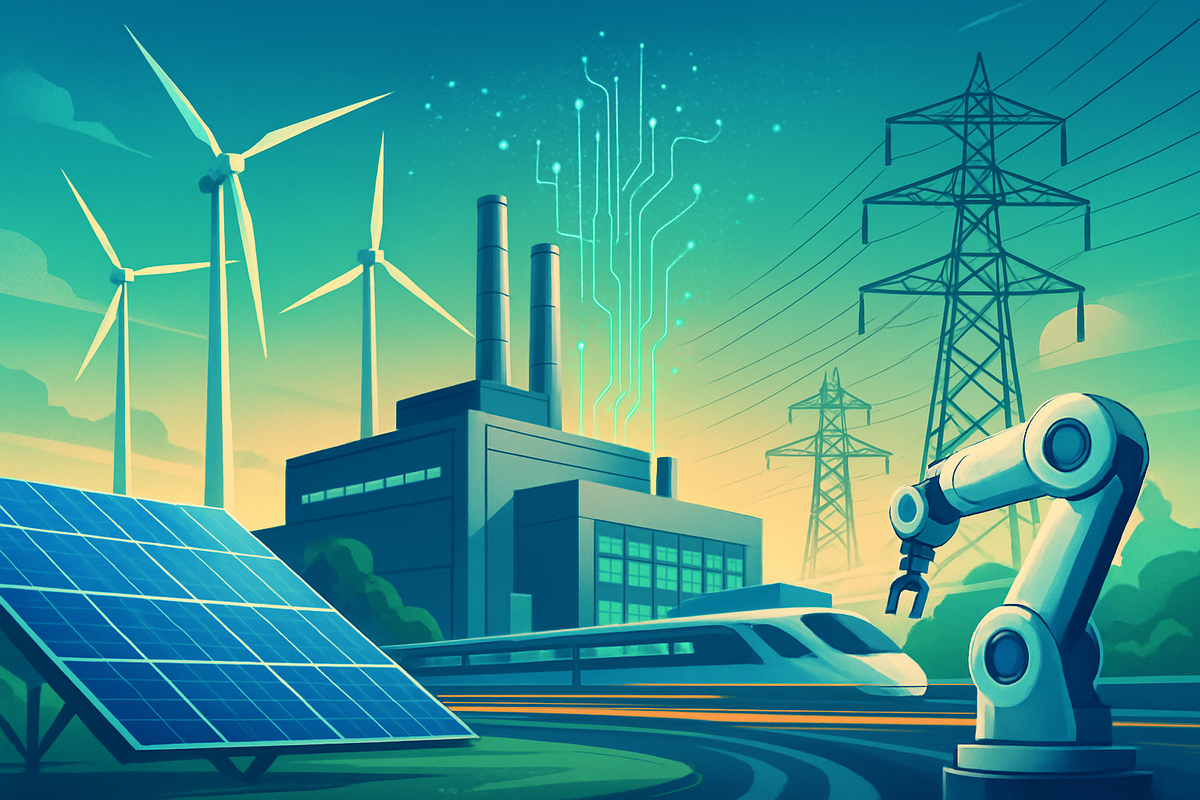
New York, NY – October 13, 2025 – The S&P 500 Industrials sector has closed today's trading session with a remarkable surge, cementing its position as a leading performer in the broader market. This significant positive momentum is largely attributed to a confluence of robust economic drivers, including ambitious reshoring initiatives, unprecedented infrastructure spending, and the accelerating global energy transition. At the forefront of this industrial resurgence is GE Vernova (NYSE: GEV), whose stock performance has topped the market, signaling strong investor confidence in companies poised to capitalize on these transformative trends.
The sector's impressive showing today underscores a deeper narrative of industrial revitalization in the United States. With a year-to-date gain of 14.5% for the S&P 500 Industrials sector, and an even more striking 26.75% for an equal-weighted index by late September 2025, the market is clearly signaling a bullish outlook. Investors are increasingly drawn to the sector's resilience and its direct ties to strategic national priorities, making its sustained growth a compelling story for both retail and institutional portfolios.
Unpacking the Industrial Surge: A Confluence of Catalysts
The strong performance of the Industrials sector is not an isolated event but rather the culmination of several powerful economic and policy tailwinds. A primary driver is the pervasive trend of reshoring and onshoring initiatives, as companies seek to mitigate geopolitical risks and enhance supply chain resilience by bringing manufacturing back to domestic soil. Government policies such as the Inflation Reduction Act, the Infrastructure Investment and Jobs Act, and the CHIPS Act are providing substantial incentives and creating immense demand for new factories, construction services, and logistics infrastructure. This legislative support is directly translating into increased industrial production and capital expenditures.
Furthermore, a monumental infrastructure spending boom is channeling significant investments into transportation networks, energy grids, and digital infrastructure across the nation. This sustained government outlay directly benefits companies supplying construction materials, engineering expertise, and heavy equipment, providing a predictable and long-term revenue stream for the sector. Simultaneously, the accelerating energy transition and electrification drive, intensified by the soaring electricity demands of artificial intelligence (AI) infrastructure, is creating unprecedented opportunities for industrial firms specializing in power generation, renewable energy components, and grid modernization. Companies that are enabling this shift are seeing their order books swell.
Adding to this positive environment are easing inflation concerns and a more accommodating monetary policy from the Federal Reserve, including expected interest rate cuts in 2025. Lower borrowing costs stimulate corporate investment in expansion and upgrades, directly benefiting industrial equipment manufacturers and service providers. This resurgence is further bolstered by a renewed focus on manufacturing and automation, with advanced technologies like AI and robotics enhancing productivity and profitability across the sector. The aging global aerospace fleet also contributes to consistent demand for parts, maintenance, and new aircraft, providing a steady revenue stream for aerospace and defense players.
Winners and Losers: Navigating the Industrial Landscape
The current industrial renaissance is creating clear winners, with companies strategically positioned to benefit from the aforementioned trends. GE Vernova (NYSE: GEV) stands out as a prime example, having demonstrated exceptional growth since its spin-off from General Electric in April 2024. Focused exclusively on power generation and grid equipment, its valuation has skyrocketed from $37 billion to $156 billion, with an impressive 97.31% year-to-date stock rally by today's close. Its leadership in gas turbine technology and grid components makes it a direct beneficiary of the energy transition and the burgeoning demand for AI-driven electricity. The company also enjoys significant tailwinds from tax credits under the Inflation Reduction Act.
Beyond GE Vernova, a broad spectrum of industrial companies are poised for continued success. Manufacturers of heavy construction equipment like Caterpillar Inc. (NYSE: CAT) are benefiting from infrastructure projects, while engineering and construction firms such as Jacobs Solutions Inc. (NYSE: J) are securing lucrative contracts for new facilities and infrastructure upgrades. Companies involved in renewable energy components and smart grid technologies, like Eaton Corporation plc (NYSE: ETN) and NextEra Energy, Inc. (NYSE: NEE), are seeing increased demand. Furthermore, firms providing industrial automation and robotics solutions to optimize manufacturing processes are also experiencing robust growth.
Conversely, companies that are slow to adapt to these evolving market dynamics may find themselves at a disadvantage. Industrial firms heavily reliant on outdated manufacturing processes, lacking investment in sustainable technologies, or with significant exposure to volatile international supply chains without a clear reshoring strategy, could face headwinds. Those unable to innovate or integrate advanced automation and AI into their operations risk falling behind more agile competitors. The shift towards domestic production also means that companies with limited U.S. manufacturing capabilities might need to re-evaluate their operational footprint to capitalize on government incentives and meet evolving customer demands.
Wider Significance: Reshaping the Economic Fabric
The robust performance of the Industrials sector signifies more than just short-term market gains; it reflects a fundamental reshaping of the economic fabric. This surge fits squarely into broader industry trends emphasizing sustainability, technological advancement, and national security. The aggressive pursuit of clean energy targets and the rapid deployment of AI infrastructure are not fleeting fads but long-term strategic imperatives that will continue to drive industrial innovation and investment for decades.
The ripple effects of this industrial momentum are extensive. Competitors are compelled to accelerate their own investments in automation, reshoring, and green technologies to remain competitive. Partnerships are forming between industrial giants and technology providers to integrate cutting-edge solutions. From a regulatory standpoint, the continued success of these initiatives reinforces the efficacy of policies like the Inflation Reduction Act and the Infrastructure Investment and Jobs Act, potentially paving the way for further government support and incentives in these critical areas. Historically, periods of significant infrastructure investment and technological shifts have often led to prolonged periods of economic growth and industrial transformation, suggesting a similar trajectory for the current cycle.
Moreover, the emphasis on domestic manufacturing has profound implications for national security and economic independence. By reducing reliance on foreign supply chains, the U.S. enhances its ability to withstand global disruptions and maintain critical production capabilities. This strategic imperative is likely to sustain political and financial backing for the Industrials sector, embedding its growth drivers deeply into national policy.
What Comes Next: Charting the Future of Industrials
Looking ahead, the short-term outlook for the Industrials sector appears bright, supported by ongoing government spending, resilient economic activity, and strong corporate earnings projections. The momentum from reshoring, infrastructure, and the energy transition is expected to continue driving demand for industrial products and services. Companies like GE Vernova are well-positioned for sustained growth as the global economy continues its shift towards electrification and AI-driven power demands.
In the long term, the sustainability of these trends will depend on continued policy support, technological innovation, and the ability of industrial firms to adapt to evolving market conditions. Potential strategic pivots will include deeper integration of AI and machine learning into manufacturing processes, further investment in sustainable and circular economy practices, and the development of new solutions for grid modernization and renewable energy storage. Market opportunities will likely emerge in specialized niches within automation, advanced materials, and smart infrastructure. Challenges could arise from potential supply chain bottlenecks for critical components, skilled labor shortages, and unexpected shifts in geopolitical landscapes or regulatory environments.
Investors should anticipate a landscape characterized by continued innovation and strategic consolidation. The sector may see further spin-offs or mergers as companies streamline operations to focus on core growth areas. The ongoing electrification of transportation and industrial processes will also present significant opportunities. Scenarios range from sustained robust growth, particularly for companies aligned with green energy and digital transformation, to periods of consolidation as the market matures and efficiency becomes paramount.
Wrap-Up: A Resilient Sector Poised for Lasting Impact
In summary, the S&P 500 Industrials sector's significant positive performance today, spearheaded by market leader GE Vernova, highlights a powerful convergence of economic and policy catalysts. The relentless drive towards reshoring, massive infrastructure investments, and the global energy transition—supercharged by the demands of AI—are fundamentally reshaping the industrial landscape. These factors are not merely transient market fluctuations but represent deep-seated structural shifts that promise sustained growth for the sector.
Moving forward, the Industrials sector is poised for continued resilience and growth, making it a compelling area for investors seeking exposure to long-term economic transformation. The market's assessment points to a sector that is not only adapting but actively leading the charge in critical areas of national importance and technological advancement. Investors should closely watch for continued government policy implementation, further advancements in industrial automation and AI integration, and the ongoing global demand for clean energy solutions. Companies demonstrating strong execution in these areas, like GE Vernova, are likely to continue delivering strong returns in the months and years to come.
This content is intended for informational purposes only and is not financial advice





